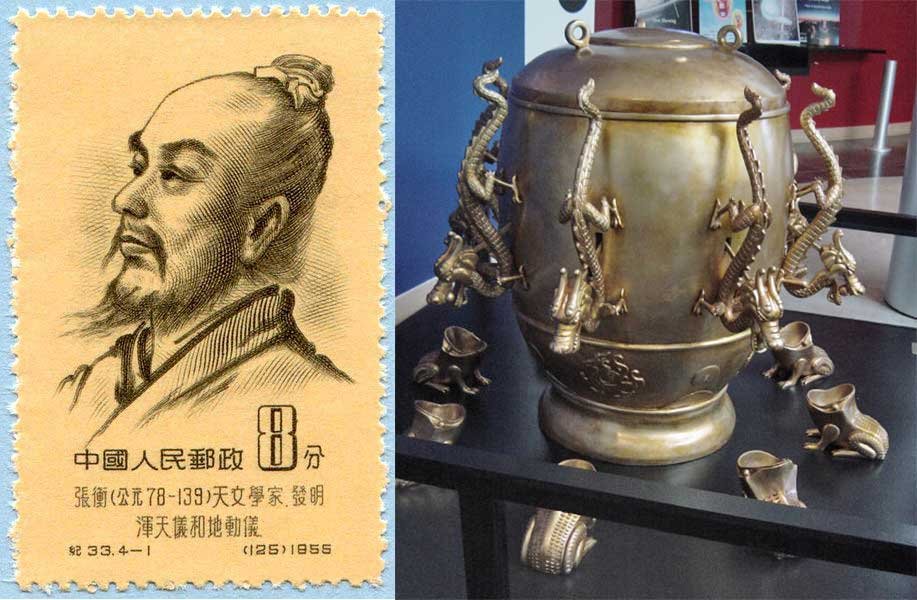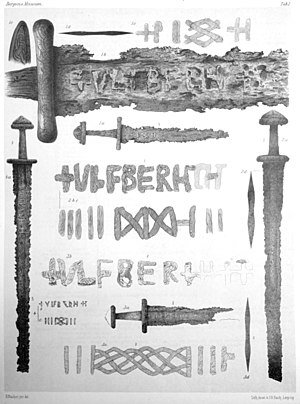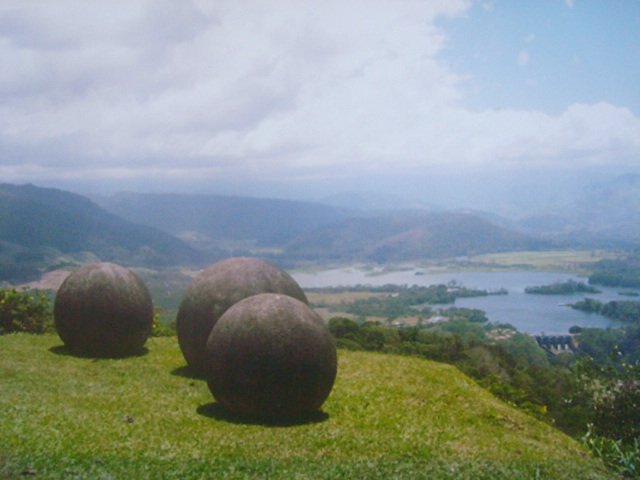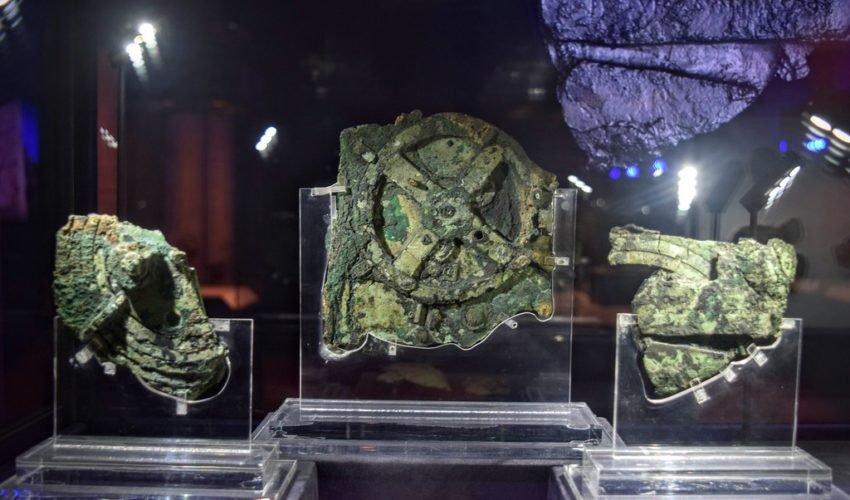Ancient Inventions doesn’t necessarily point to aliens or time traveler’s help to ancient humans with their technology, these Ancient Inventions are more about mysterious and sometimes weird inventions that not even modern science could explain, either because of the lost history or the lost technology behind these maybe? What’s actually the truth behind this mysterious Ancient Inventions?
Follow the list below and find out some of the coolest mysterious ancient inventions, unexplained discoveries and some slightly more recent finds still baffling to scientists in 21st century.
8. A Mysterious Astrological Calendar — The Antikythera Mechanism

Greek inventors would have been very advanced in their time to invent The Antikythera Mechanism, which is an ancient hand-powered Greek analog computer, and often described as the first example of such device.
This artifact was discovered at the bottom of the sea in 1901, among wreckage retrieved from a shipwreck off the coast of the Greek island Antikythera. This mind-boggling device was likely developed around the end of the second century BC. It “determined and showed celestial information, especially cycles, for example, the phases of the moon and a lunisolar powered schedule,” a suggested use of the device. Upon discovery, the Antikythera Mechanism was housed in the remains of a wooden box.
Although, no one knows who built it, used it, and what they even used it for exactly. It’s also hazy why it is “more fact more intricate than any known device for at least a millennium afterward”. The Antikythera Mechanism has a complex clockwork mechanism composing of around 30 meshing gears made of bronze. To study Antikythera more deeply, Mike Edmunds and Tony Freeth at Cardiff University led a team to read the faintest inscriptions that once covered the outer casing of the machine, using modern computer x-ray tomography.
As Brian Dunning of Skeptoid notes points out, similar gear-based technology was around more than two centuries earlier, and Occam’s Razor reveals that any “siblings” of the Antikythera Mechanism, like most commonplace bronze objects of the period, were likely “recycled” into other objects.
7. Greek inventor’s deadly “Greek Fire” — A family secret

Scientists and historians are nonetheless very curious about 7th century “Greek Fire“. Eastern Roman Empire (The Byzantine Empire) used Greek Fire which was one of their incendiary weapon, a deadly proto-napalm compound thrown at enemies’ a weapon mounted on Byzantine ships. Scientists believe that the reason for it being so deadly was the fact that it could be ignited on contact with water, probably because the compound used was naphtha and quicktime, thus Byzantine used their “secret” weapon mostly in the naval battles with great effect.
What made it more deadly was that it was impossible to extinguish with water and obviously there were no fire extinguishers existed in that time, definitely a nightmare!
The composition of this deadly recipe remains a mystery and a matter of debate since many argue about it being a combination of pin resin, naptha, quicktime, calcium phosphite or niter. Still, the recipe for Greek Fire remains a protected family secret.
6. Ancient Chinese invention used to detect Earthquakes — Zhang Heng’s Seismoscope

Zhang Heng (79-139 A.D.) was the Leonardo da Vinci of ancient China, an inventor, astronomer, engineer, scientist, scholar, and artist. He invented the first earthquake detecting tool, an ancient, art-science, sculptural device that was ornate, golden, dragon-festooned, toad surrounded vessel which could remotely detect earthquakes hundreds of kilometers away.
Zhang Heng believed that earthquakes were caused by wind and air, thus this Seismoscope work when earth quakes, a bronze ball is dropped from one of eight tubed projections shaped as dragon heads into the mouth of toad’s placed directly below these dragon’s heads, the dragon’s representing the principal directions of the compass, indicating the direction of the earthquake.
No one to this day has an idea about this Chinese ancient invention, Zhang Heng’s Seismoscope, neither any clear historical documents exist or how it worked inside since the original device is not in existence anymore. Several reconstruction designs have been attempted to replicate this device from the past 150 years, but the original device remains mysterious. Some believe that it could have been a simple pendulum-based system, but the exact science behind it remains a mystery to this day.
5. No one knows how Vikings made their Ulfberht Swords — Best Swords of all time

Talking about ancient inventions of weapons, the legendary swords of the Vikings which used techniques that remain a mystery for making their Ulfberht Swords. What makes these Viking blades more interesting is the fact that when archeologists discovered the Viking Swords, they couldn’t believe as the technology needed to produce such metal would not be invented for another 800 years.
There are around 170 Ulfberht Swords known from Europe, most numerously in Northern Europe.
Although the origin of the Ulfberht Swords is most likely in the Rhineland region (Austrasia), but it is still debatable where the first blade was actually made. But in 2017, a 9th century Viking grave was discovered in Scandanavia with an Islamic inscription meaning “For/To Allah”, linking the two worlds and making the shared knowledge plausible – but it’s just a guess.
4. How a 1600 years old Iron Pillar in Delhi never rusts — Scientists still baffled

Iron or steel (which is iron with some added carbon) begins to “rust” the millisecond it’s exposed to oxygen. It’s a natural chemical reaction between the oxygen atoms and the carbon atoms. But how a 1600 years old Iron Pillar stands still without being rust in Delhi, India has baffled scientists from around the globe.
Environmental specialists say that the mild climate of Delhi is ultimately the reason, right place, right time! While Material scientists have a different theory suggesting the Iron Pillar has a presence of Phosphorus and the absence of sulfur and manganese plus the large mass of the pillar making it resistant to rusting.
However, it’s a total mystery how the rustproof iron lumps were welded to create the enormous six-ton structure. Regardless, it’s an amazing ancient piece of engineering.
3. Roman dodecahedron — A fortune-telling device or just a Candlestick

Looking like some ancient paperweight, a Roman dodecahedron is one of the most mysterious ancient inventions, a small hollow 12 sided spheroid object made of bronze or stone. Hundreds of these tiny mysterious pieces have been found from Wales to Hungary and Spain and to the east of Italy. Yet, no one has any idea of for what exact purpose these were used.
Roman dodecahedron could have been used as candlesticks since the presence of wax was found inside in two of these, or might be a dice, or as some believe these have been religious artifacts or even fortune-telling devices.
2. Damascus Steel Recipe — Still a mystery
Maybe Viking used Damascus Steel for making their Ulfberht Swords? Damascus steel was the manufactured steel of the sharp blades smithed in the Near East from ingots of Wootz steel, imported from Southern India and Sri Lanka is known as Sinhala Wane and wielded by Islamic Warriors.
Such blades were rumored to be extreme, impervious to breaking, and fit for being sharpened to a sharp, strong edge to an extent that could slice a floating handkerchief, these swords are characterized by distinctive patterns of banding and mottling reminiscent of flowing water.
Yet the recipe for these so-called Damascus Steel is still a mystery. The best guess is that the blades consisted of “crucible steel” which is created by melting iron with plant matter, but the exact type of crucible steel used is still unknown.
1. Use of Stone Spheres of Costa Rica is still a mystery

Numerous myths surround the Giant Stone Spheres of Costa Rica, one being that these originated from Atlantis, or that they were made commonly. It has been claimed that the spheres are perfect, or very near perfect in roundness
Although scientists may have an accurate idea of this ancient invention and how these Giant stone balls in Costa Rica were formed. The local occupants approached an elixir ready to mellow the stone. Limestone, for instance, can be broken down by acidic arrangements acquired from plants. Research drove by Joseph Davidovits of the Geopolymer Institute in France has been offered on the side of this hypothesis.
But the reason of why they did it is still a mystery. Some gullible vandals even blew the balls up, hoping to find gold in these balls. (They didn’t.)
Now since you have read about these mysterious Ancient Inventions, you might like reading about these 10 Mysterious Books from History that known one has an explanation about. You might also like 10 Last Minute Decisions that Changed the World.










